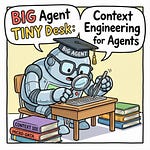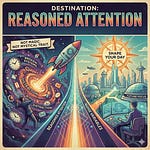I tend to get pretty turned off by AI hype, and my favorite example of AI hype these days is AI context windows. So being me, I wrote a piece about what the heck is actually going on under the surface, why it works that way architecturally, and how to fix it. Oh, and I threw some AGI reflections in there just for fun!
Why bother? I get a LOT of messages that basically boil down to “I was promised a great context window that held all this stuff, and I put all this stuff in it—and this supposedly smart model just crapped out on me.” People think the problem is them, or the prompt. When it’s often mismanagement of the context window coupled with believing vendor hype. We’ll address both here.
Imagine this: You’ve finally convinced your CTO to approve a hefty investment in an AI solution that promises to understand, retain, and process vast amounts of information effortlessly—“1M tokens of context!” the vendor boasted. Everyone was excited, thinking you’ve just purchased the digital equivalent of a photographic memory. Then, reality strikes. Important details from page 40 (or 400) of your critical legal document vanish as if they’d never existed. The financial analysis that hinged on precise figures scattered throughout an extensive quarterly report? Completely botched. Your AI is hallucinating, forgetting instructions, and leaving you wondering if you’ve made an expensive mistake.
You’re not alone. Welcome to the Context Window Trap.
It’s 2025, and we’ve arrived at a pivotal moment in AI where promises and practicalities are diverging rapidly. As you read this, countless teams worldwide are discovering the unsettling truth about long-context AI models: they don’t quite work as advertised. This isn’t just an annoyance—it’s a fundamental barrier threatening to stall progress across industries from healthcare to finance, from legal to software development.
What was sold was perfect memory, what we got was a fairly lossy semantic meaning pattern matcher with big holes.
But why does this matter so urgently right now?
Because the problem isn’t just about models forgetting. It’s about what that forgetting reveals about the nature of AI itself. When your “cutting-edge” model with a 1M-token capacity behaves like it has just a fraction of that, it’s not simply a technical glitch. It’s a window into the very essence of how these models function—and more importantly, how they don’t.
In this essential guide, we’re going to explore the uncomfortable reality behind the “lost in the middle” phenomenon. You’ll understand exactly why models struggle to maintain coherence over extensive contexts, how their underlying architecture—built on probabilistic attention mechanisms—sets them up for failure, and why scaling up the context size isn’t the silver bullet vendors claim it to be.
But this guide is more than a wake-up call; it’s a practical blueprint. Because despite it all, I definitely still see powerful AI systems every day. AI is worth building—but as this newsletter emphasizes—you have to pay attention to the details to get the value you are looking for out of AI! It is not a magic wand.
Anyway, inside I stuffed all the secret sauce for beating the context window problem. Yes, that means it’s one of my classic longer posts, but you are human, and you can use smart strategies to get what you want out of a full guide. I toyed with cutting it, and ultimately I figure you deserve a full guide to one of the biggest problems in AI right now. It’s too critical to get this right if you want to build systems that work.
What we're really talking about here is the difference between using AI and architecting with AI. Any fool can yeet 100K tokens into a prompt. It takes understanding to know when to chunk, when to retrieve, when to summarize, and when to tell the model exactly where to look. That's not a limitation – that's craftsmanship.
The strategies in here are used by actual production teams and genuinely work: intelligent chunking methods, smart retrieval systems, strategic summarization chains, and more. We’ll walk through tailored industry-specific playbooks to tackle your exact use-cases, whether you’re navigating intricate contracts in legal, dissecting dense financial reports, synthesizing extensive healthcare records, or analyzing vast software codebases.
We’ll also critically assess the cost implications of these oversized contexts—real numbers and real scenarios—to ensure your CFO won’t have a heart attack when the bill arrives.
Ultimately, this is a call to action: The smartest teams aren’t waiting for a magical “fix” promised by future AI versions. They’re proactively architecting around these fundamental limitations, adopting methods that don’t just sidestep the problem but actively leverage AI’s strengths. Whether you’re a believer in the potential for AGI or a skeptic seeing these systems as glorified pattern-matchers, the strategies outlined here will significantly elevate your approach.
The Context Window Trap is real, it’s significant, and addressing it isn’t optional—it’s critical. Let’s dive in and start building with the context windows we have—not the Cinderella context windows we’re promised lol
Listen to this episode with a 7-day free trial
Subscribe to Nate’s Substack to listen to this post and get 7 days of free access to the full post archives.













